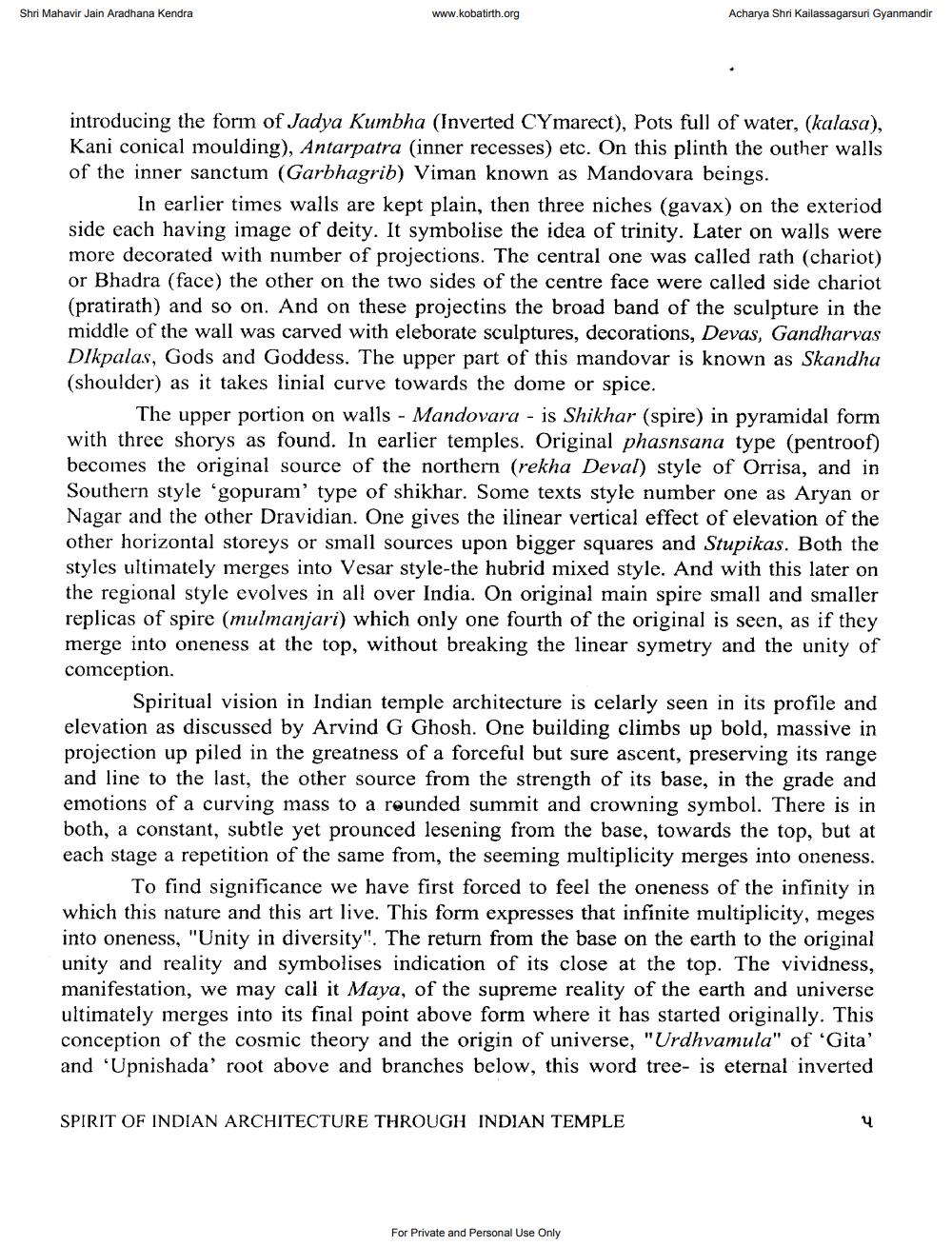________________
Shri Mahavir Jain Aradhana Kendra
www.kobatirth.org
Acharya Shri Kailassagarsuri Gyanmandir
introducing the form of Jadya Kumbha (Inverted CYmarect), Pots full of water, (kalasa), Kani conical moulding), Antarpatra (inner recesses) etc. On this plinth the outher walls of the inner sanctum (Garbhagrib) Viman known as Mandovara beings.
In earlier times walls are kept plain, then three niches (gavax) on the exteriod side each having image of deity. It symbolise the idea of trinity. Later on walls were more decorated with number of projections. The central one was called rath (chariot) or Bhadra (face) the other on the two sides of the centre face were called side chariot (pratirath) and so on. And on these projectins the broad band of the sculpture in the middle of the wall was carved with eleborate sculptures, decorations, Devas, Gandharvas Dikpalas, Gods and Goddess. The upper part of this mandovar is known as Skandha (shoulder) as it takes linial curve towards the dome or spice.
The upper portion on walls - Mandovara - is Shikhar (spire) in pyramidal form with three shorys as found. In earlier temples. Original phasnsana type (pentroof) becomes the original source of the northern (rekha Deval) style of Orrisa, and in Southern style 'gopuram' type of shikhar. Some texts style number one as Aryan or Nagar and the other Dravidian. One gives the ilinear vertical effect of elevation of the other horizontal storeys or small sources upon bigger squares and Stupikas. Both the styles ultimately merges into Vesar style-the hubrid mixed style. And with this later on the regional style evolves in all over India. On original main spire small and smaller replicas of spire (mulmanjari) which only one fourth of the original is seen, as if they merge into oneness at the top, without breaking the linear symetry and the unity of comception.
Spiritual vision in Indian temple architecture is celarly seen in its profile and elevation as discussed by Arvind G Ghosh. One building climbs up bold, massive in projection up piled in the greatness of a forceful but sure ascent, preserving its range and line to the last, the other source from the strength of its base, in the grade and emotions of a curving mass to a rounded summit and crowning symbol. There is in both, a constant, subtle yet prounced lesening from the base, towards the top, but at each stage a repetition of the same from, the seeming multiplicity merges into oneness.
To find significance we have first forced to feel the oneness of the infinity in which this nature and this art live. This form expresses that infinite multiplicity, meges into oneness, "Unity in diversity". The return from the base on the earth to the original unity and reality and symbolises indication of its close at the top. The vividness, manifestation, we may call it Maya, of the supreme reality of the earth and universe ultimately merges into its final point above form where it has started originally. This conception of the cosmic theory and the origin of universe, "Urdhvamula" of 'Gita' and 'Upnishada' root above and branches below, this word tree- is eternal inverted
SPIRIT OF INDIAN ARCHITECTURE THROUGH INDIAN TEMPLE
For Private and Personal Use Only




